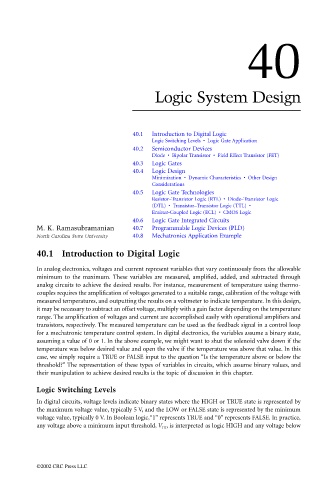Page 1091 - The Mechatronics Handbook
P. 1091
40
Logic System Design
40.1 Introduction to Digital Logic
Logic Switching Levels • Logic Gate Application
40.2 Semiconductor Devices
Diode • Bipolar Transistor • Field Effect Transistor (FET)
40.3 Logic Gates
40.4 Logic Design
Minimization • Dynamic Characteristics • Other Design
Considerations
40.5 Logic Gate Technologies
Resistor–Transistor Logic (RTL) • Diode–Transistor Logic
(DTL) • Transistor–Transistor Logic (TTL) •
Emitter-Coupled Logic (ECL) • CMOS Logic
40.6 Logic Gate Integrated Circuits
M. K. Ramasubramanian 40.7 Programmable Logic Devices (PLD)
North Carolina State University 40.8 Mechatronics Application Example
40.1 Introduction to Digital Logic
In analog electronics, voltages and current represent variables that vary continuously from the allowable
minimum to the maximum. These variables are measured, amplified, added, and subtracted through
analog circuits to achieve the desired results. For instance, measurement of temperature using thermo-
couples requires the amplification of voltages generated to a suitable range, calibration of the voltage with
measured temperatures, and outputting the results on a voltmeter to indicate temperature. In this design,
it may be necessary to subtract an offset voltage, multiply with a gain factor depending on the temperature
range. The amplification of voltages and current are accomplished easily with operational amplifiers and
transistors, respectively. The measured temperature can be used as the feedback signal in a control loop
for a mechatronic temperature control system. In digital electronics, the variables assume a binary state,
assuming a value of 0 or 1. In the above example, we might want to shut the solenoid valve down if the
temperature was below desired value and open the valve if the temperature was above that value. In this
case, we simply require a TRUE or FALSE input to the question “Is the temperature above or below the
threshold?” The representation of these types of variables in circuits, which assume binary values, and
their manipulation to achieve desired results is the topic of discussion in this chapter.
Logic Switching Levels
In digital circuits, voltage levels indicate binary states where the HIGH or TRUE state is represented by
the maximum voltage value, typically 5 V, and the LOW or FALSE state is represented by the minimum
voltage value, typically 0 V. In Boolean logic,“1” represents TRUE and “0” represents FALSE. In practice,
any voltage above a minimum input threshold, V IH , is interpreted as logic HIGH and any voltage below
©2002 CRC Press LLC

